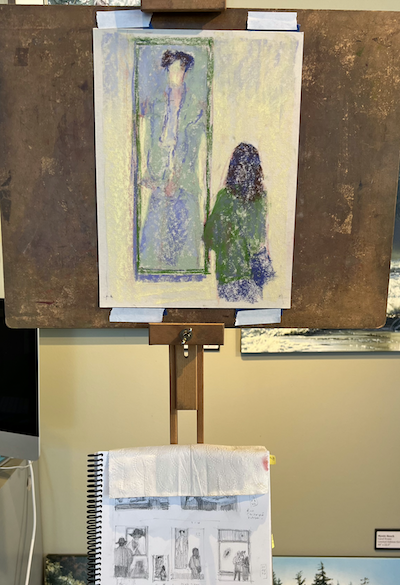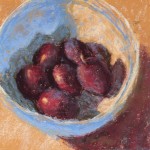Another painting in my Gallery Goers series is done! It’s such a great feeling when you think a painting is finished.
But then I came back a few days later. Something wasn’t quite right. I hadn’t noticed it while working on the piece – too close to it physically, mentally, and emotionally. I needed some time away for the problem to jump out at me.
Before we get to the issue, let’s have a look at the progression through the painting.
It was one I started as a demo at the Peninsula Gallery.
Here’s the reference photo that I took at an exhibition of Gustav Klimt’s work at the Legion of Honor Museum in San Francisco. It’s of Klimt’s “Portrait of Gertrud Loew.” I decided to leave out the man to the left and concentrate on the Klimt painting and its relationship to the woman looking at it.

Then, if you know me, you know what comes next! Thumbnails! You can see that I tried a couple of different variations but in the end, I liked the viewer overlapping the painting.

I drew up the piece in a red pastel pencil and then went over the figure of Gertrud with an HB pencil.

Then come the first layers in dark, middle, and light. You’ll see that I took liberties with colour accuracy regarding Klimt’s painting. I didn’t want to use greys so I created a cooled greyed look instead

A second layer has begun but really, I didn’t get very far while at the gallery – too much chatting and having fun!

At home, I started to add more pastel and fine-tune all the parts especially the Klimt painting of Gertrud.


I knew that Gertrud in my painting looks a lot older than the woman in Klimt’s painting but at this point, I let that go. It’s hard enough trying to reproduce an oil painting in pastels, especially at the size I’m doing (12 x 8 in approx) let alone get the face accurate with big sticks of pastels!

The painting is finished! Yay!
Not so fast Gail…
A few days later I came back and noticed what I hadn’t seen before.
The light part in the painting of Gertrud looked almost like it was the colour of the wall coming through. And it drew too much attention! What I’d done, I realised, was near the end of the painting session, I’d gone in and added the light part with more pressure to make a denser light alongside Gertrud’s dress. Argh!

The tricky thing with figures is that a face will always call attention to itself. My task as an artist is to make sure the eye of the viewer of my painting travels throughout and didn’t get stuck on the face. I do that by value changes, colour accents, and edge hardness or softness. Generally, I think I got that all working but this newly discovered problem needed to be attended to before I could call the painting finished!
So I went about cooling the wall alongside the painting and greying the light areas in the painting alongside the figure. I also softened the edges of the dress.
All very subtle changes but I think (hope!) for the best!
Here’s the final painting.

Here are the two versions side-by-side. Very subtle changes but I think the time spent fixing what I saw as a problem was beneficial in the end.


And here are the nine pastels I used.

And here are two close-ups – one of Gertrud’s face and the other of her gown and hand and a bit of the viewer.


I hope you agree that my painting is finished, finally. It’s a tricky thing knowing when a painting is finished, and when to call it quits. It’s easy to overwork! I’ll leave that conversation for a future blog post.
I’d love to hear your thoughts! Was this helpful? Did you see the problem when I pointed it out? Do leave a comment and let me know!
Until next time,
Gail
PS. The painting by Gustav Klimt came to auction in 2015. Sotheby’s put together this short video about it.
































16 thoughts on “My Painting Is Finished! Or Is It?”
Wonderful result Gail! Time away from a piece of work allows ‘creative dormancy,’ a period of working on the piece while not literally working on it. It’s often a really valuable and rewarding phase of the process, as demonstrated by the evolution of this painting.
Diane! How lovely to see you pop up here 😁 Thank you for your positive feedback!
And thank you for reaffirming this need to take time away. As you say, we never stop thinking about our work. Love the term “creative dormancy.” (For any one interested, have a read of Diane’s guest post!)
Thank you for sharing this, Gail! I really found this beneficial, especially since I can stare at my own work on occasion, thinking, ‘Something’s not right!’, and have to put it away for a while to figure it out.
So glad to hear it was beneficial Evelyn! Sounds like you’ve discovered the benefit of putting your work away. It’s always a wonderful thing to come back and know what to do about that feeling that “something’s not right.”
Love your process and progress info. Don’t know why, but I wanted a smidge more blending of their hair. My eyes Kept getting stuck there, but that’s
probably just me as I do more blending with my pastels. But, so so glad I found you. Thanks.
Thanks Linda! I’m so glad you found me and this blog too!
And I appreciate your input. It’s interesting that your eye goes to the hair and I can see that that might happen. I was so concerned about getting the eye to move away from Gertrud’s face and doing all I could to make sure that happened. In the real piece, I don’t think the hair looks as dark or attention-grabbing as it does in the photo..but I’m not sure!
Thanks for the encouragement to set the painting aside for a short while. After working and staring, I sometimes can’t see what is needed – a break is just the thing!
Yes! It really does help to take a break Lori. This is true for when you are working on a piece that takes time but especially as you are nearing what seems to be the finish line!
I can totally relate to finding a correction, when you came back to your work.
It has happened to me on numerous occasions as well.
This tells us, not to consider our work finished, until we’ve had a break from it and looked at it with fresh eyes! 😁😁😁
Ed – YES! That’s it exactly!! Thank you 😁
Yes! I love the term Creative Dormancy. In fact I have a box full of dormant paintings! The subtle changes you made definitely help the painting to finish. I do wonder if you had a reason for changing temperature/value of the viewer’s sweater right at the strap line of her purse? On such a small piece, it’s not so noticeable, but when you zoomed in…Just curious.
Hah hah…I think we all have a stack of those!
Interesting question ES…and I’m not exactly sure what you mean. And…I’m not sure if I would have an answer for you. It’s cooler, lighter, and greyer on the back of her sweater. I would have made those changes to show ambient light. But really, I can’t tell you why exactly. It’s fascinating to notice these things through a viewer’s eyes!
Thank you for this I always struggle to finish a painting but usually end up making it look overworked. You made subtle changes in the right areas to make it work. If you didn’t point out the problem with the background I probably would have accepted it as a finished painting.
Michele, I’m so happy to know this was helpful. It was such a subtle change but when I saw what I did, it became glaring and needed some tweaking! It’s a fine balance to tiptoe between finishing and overworking.
Gail thank you for sharing the process- very helpful as I work to redevelop my pastel power. I liked your finished work. I saw Klimt’s work in Vienna and was so impressed- now I have his images even on my mugs! I feel that you have taken the spirit of his painting and made it your own by introducing the viewer.
I was interested to note in the close-up detail that you don’t need to cover every square millimeter with pastel- I shall try to leave some breathing spaces in my color.
Thanks so much Sally!
And isn’t seeing Klimt’s work in the real something?! I too first saw his work in Vienna when I was travelling in my early twenties. I was blown away after only seeing his work in slides and books.
And thank you for looking deeply at my work.I think working lightly gives you the freedom to change and layer. And when you need to add the pastel heavily, you have the tooth (in the paper) to do it!